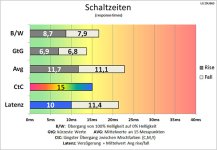You are using an out of date browser. It may not display this or other websites correctly.
You should upgrade or use an alternative browser.
You should upgrade or use an alternative browser.
**The Massive TFT Sticky - FAQ, Links and Buyers Guide**
- Thread starter Baddass
- Start date
More options
View all postsRecalibration should be done every few months or so as backlight characteristics change with age. If you buy anything too cheap you might as well not bother and stick with by eye calibration and basic osd adjustments. Otherwise cheap instruments will just create equally inaccurate results
you'll need to be a little careful with comparing different sources for a few reasons.
Firstly, those results you've included for the LG are for the "fast" overdrive setting and that introduces a lot of overshoot as reported in the Prad review. it's probably not a fair comparison with the Acer tests which are at the optimum "normal" OD setting where there is no overshoot at all. A better comparison between the two would be with the LG set to "medium" as per this:

and compare that with the Acer tests you provided:

i'm not really sure what some of the Prad figures there are supposed to represent to be honest, it's a bit confusing. looking at it, their "avg" figures would be the closest measurement to what i am measuring in the TFTCentral tests there. so on the LG at "medium" overdrive mode the average G2G is 11.1 - 11.7ms G2G. that would be a fairly typical average G2G response time for a 60Hz IPS panel like that and looks realistic. their "fast" overdrive setting pushes G2G to 8 - 8.3ms G2G but at the cost of some heavy overshoot, which is again typical.
So in this comparison i would say you're comparing the LG with about 11.5ms G2G response time vs the Acer at 8.6ms G2G (when at optimal overdrive setting with no overshoot introduced).
Response times do have some impact on motion clarity although it's going to be fairly minimal unless the difference was more significant. i would expect to see some motion clarity improvements from response times alone between the LG and Acer there. There is an additional motion clarity impact then based on refresh rate, which improves motion clarity. So the Acer you've referenced there (the XR341CK) runs at 75Hz which will offer some improvement again compared with a 60Hz panel. if you pushed refresh rate higher still to 100, 120, 144Hz it would again improve motion clarity. From there, you're reaching the point of diminishing returns which is where blur reduction backlight systems then come in as the next step to improve motion claritfy significantly
Firstly, those results you've included for the LG are for the "fast" overdrive setting and that introduces a lot of overshoot as reported in the Prad review. it's probably not a fair comparison with the Acer tests which are at the optimum "normal" OD setting where there is no overshoot at all. A better comparison between the two would be with the LG set to "medium" as per this:

and compare that with the Acer tests you provided:

i'm not really sure what some of the Prad figures there are supposed to represent to be honest, it's a bit confusing. looking at it, their "avg" figures would be the closest measurement to what i am measuring in the TFTCentral tests there. so on the LG at "medium" overdrive mode the average G2G is 11.1 - 11.7ms G2G. that would be a fairly typical average G2G response time for a 60Hz IPS panel like that and looks realistic. their "fast" overdrive setting pushes G2G to 8 - 8.3ms G2G but at the cost of some heavy overshoot, which is again typical.
So in this comparison i would say you're comparing the LG with about 11.5ms G2G response time vs the Acer at 8.6ms G2G (when at optimal overdrive setting with no overshoot introduced).
Response times do have some impact on motion clarity although it's going to be fairly minimal unless the difference was more significant. i would expect to see some motion clarity improvements from response times alone between the LG and Acer there. There is an additional motion clarity impact then based on refresh rate, which improves motion clarity. So the Acer you've referenced there (the XR341CK) runs at 75Hz which will offer some improvement again compared with a 60Hz panel. if you pushed refresh rate higher still to 100, 120, 144Hz it would again improve motion clarity. From there, you're reaching the point of diminishing returns which is where blur reduction backlight systems then come in as the next step to improve motion claritfy significantly
i think you'd see some moderate improvements in motion clarity thanks to the reduced response times/removal of overshoot, and the increased refresh rate. You'd obv get a decent increase in screen size and resolution too
moving to a higher refresh rate IPS panel like the Acer Predator X34 at 100Hz would show more of a change, but i'm assuming you're an AMD freeSync user here?
moving to a higher refresh rate IPS panel like the Acer Predator X34 at 100Hz would show more of a change, but i'm assuming you're an AMD freeSync user here?


